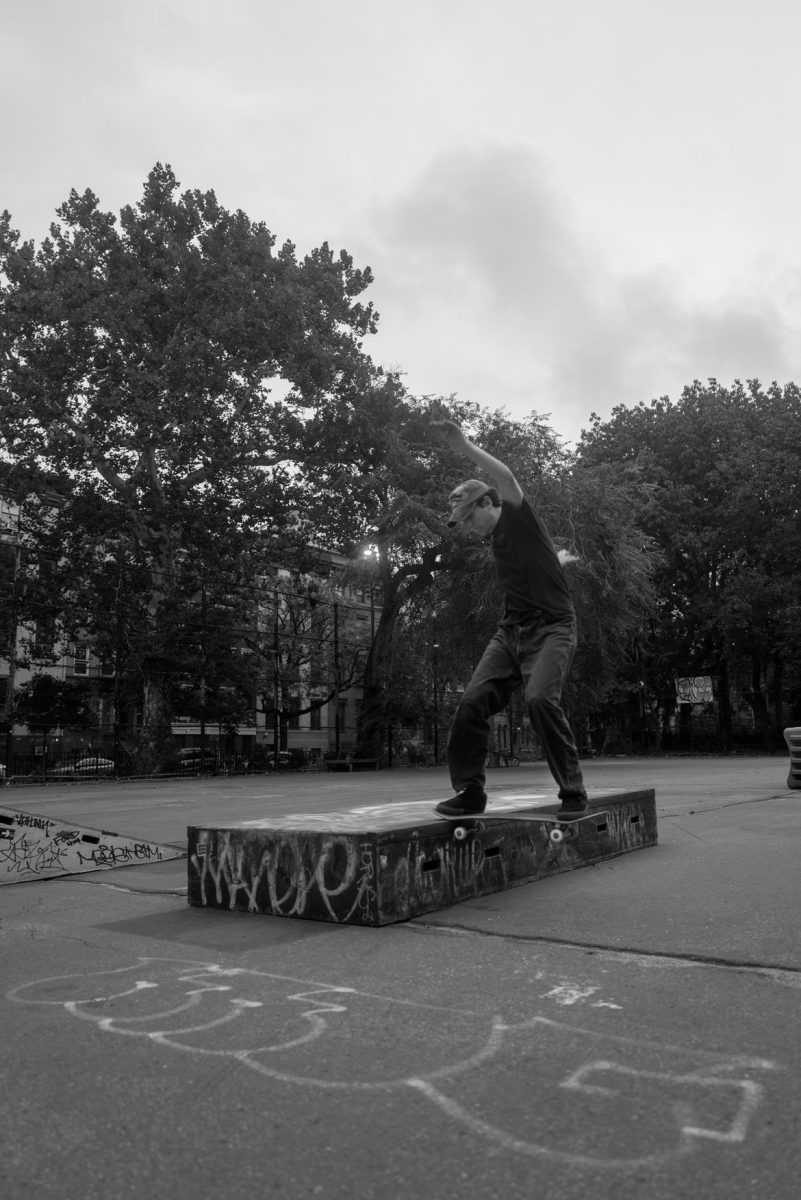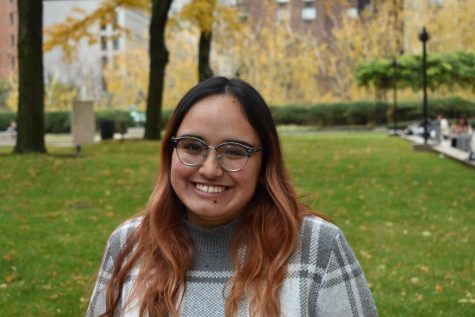The American skating subculture has existed since the 1960s, but drastically increased in popularity in the 90s and early 2000s, with professional skaters garnering celebrity status and, of course, pop-star Avril Lavigne’s hit track “Sk8ter Boi.” Skating has maintained its popularity through recent years, with its creative risk blowing up on TikTok. Additionally, the sport was just recently introduced as an official Olympic sport by the International Olympic Committee in 2020 for the Tokyo Olympics, but did not take place until 2021.
Throughout my time at Fordham I’ve witnessed several students meandering with their skateboards — and after almost getting hit by a skater on campus on a cold March day earlier this year — I began searching around campus to see if a skating community existed. After asking around, I stumbled upon a gritty yet freeing skating scene hidden within Fordham’s Lincoln Center and Rose Hill campuses.
At a glance, these skaters look as if they were pulled from the 2018 film “Mid90s.” From the baggy pants, loose fitting shirts and carabiner keychains that can be heard throughout the hallways of Fordham; and of course, the boards that each student is carrying. These skaters can usually be found at Columbus Circle, skating right outside of the 59th Street station.
The skating scene on campus surged post-pandemic when Andrew Labell, Gabelli School of Business at Lincoln Center (GSBLC) ’25, began skating at Columbus Circle in search of community and found other Fordham students along the way. This close community holds different backgrounds and paths that drove them to partake in skateboarding in college.
“My first years of college have improved my skating abilities and my confidence in riding in public, next to a crowd.” Andrea Suarez, FCLC ’25
Andrea Suarez, Fordham College at Lincoln Center (FCLC) ’25, picked up her first board back in 2020, during the pandemic when she found her father’s skateboard in their attic. Her father was able to teach her how to use a skateboard and how to go down hills as a beginner. Since then, she has been skating all around the world in places like Switzerland and New York.
“I wanted to learn a new skill, a hobby that would keep me busy and distracted during the pandemic. I wanted to stay active and spend time outdoors, because I felt isolated from nature,” Suarez said.
From that day forward, Suarez continued to skate and she can be found skating around either campus. She mentions that skating around Fordham and New York City in general has helped them feel more confident with skating and performing the skating tricks that she had previously only fantasized about.
“My first years of college have improved my skating abilities and my confidence in riding in public, next to a crowd,” she said.
Although Suarez gained a lot of confidence since the beginning of her skating journey, she also faced the gender inequality that many female skaters confront when picking up the sport. Suarez explained that she feels intimidated by the men that skate because of the lack of inclusivity that comes with skating.
“They can be less inclusive to including women in their skateboarding groups or (think) that they show more expertise than we do,” Suarez stated.
“New York has so many famous (skating) spots I’ll just be walking around and I’ll see so many spots I watched people skate in videos growing up.” Cameron Amouzgar, FCRH ’26
Cameron Amouzgar, Fordham College at Rose Hill ’26, however, is a different type of skater; he never had any intentions of ever being serious about the sport. He was given a skateboard and felt that it needed to be used. He got his first skateboard at the young age of eight, but found skating to be stimulating, with the pastime allowing him to take his negative emotions out at the skatepark.
“A friend got me into it. He had an extra board I would borrow and eventually I got my own. We’d go to the skatepark together but we didn’t really know what we were doing,” Amouzgar said.
Amouzgar said that he believes that skating is his top priority and tries to skate whenever he can because of how freeing it makes him feel. He’s skated in different cities like London, Paris, Boston and Los Angeles. New York City is still his favorite place to skate because of the people and the large skating community that it houses.
“New York has so many famous (skating) spots I’ll just be walking around and I’ll see so many spots I watched people skate in videos growing up,” he said. “I get so excited and I’ll go check them out and people think I look crazy because I’m getting hyped over a bench or like a set of stairs.”
But no matter their proficiency, skaters are no strangers to tricks and injuries. At times this fact can be frustrating. Ward feels hesitant at times when attempting skating tricks and Amouzgar experiences some insecurity.
At Andy Kessler Skate Park, located in Riverside Park, right by the Westside Highway — a popular practice site for Fordham skaters — both children and adults must sign a waiver before entering the skating bowl, which is a sunken concrete circle for skaters to perform tricks in. There you can find open space, different sized ramps, half pipes, and a grind rail. Everything a skater would need to perform skating tricks.
Attempting and executing a skating trick is essential to almost any skater, but at times it can be difficult to complete these tricks. According to Ward, your mental health could take a toll if you can’t complete a skating trick or if you get injured. Amouzgar has fallen down, Ward has hit her head before, and the anger increases the more you get injured.
“It’s either just talking yourself through the trick, going through every swear in the book or radio silence,” Amouzgar said.
Although this Fordham skating scene is meant to be freeing, it can also contain jealousy and serious imposter syndrome. Dailey Ward, FCLC ’25, said that her imposter syndrome takes over at times, which can make her feel inadequate as a skater.
“There are always so so so many people who are better than you, which can be hard to keep up with,” Ward said.
Back in West Virginia, the sport not only provided Ward with confidence and an athletic outlet, but it also served as a reality check about the hardships that many in the skating community face.
She knows the deep impact and importance of a skating community. Since attending Fordham, she has been part of the skating scene at the University and continues to skate in New York City.
Ward began skating during her junior year of high school, in West Virginia, and grew up with the skaters there. She met many older punk-based skaters that learned the most complicated skating tricks. This West Virginia scene advised Ward to keep on skating with confidence, even if that meant not landing tricks or feeling imposter syndrome — and to stay away from dangerous substances that ran rampant in her hometown in West Virginia. This internalized advice shaped the type of skater that Ward is now.
Ward agreed that New York City has so many skating spots, but she said it can be difficult to keep up with skaters in this city because there are some that can do better tricks or have more time to skate as opposed to other skaters.
Since starting college, Ward struggles to find time to skate, but strives to keep up with the sport because she said that it is an important part of her life. Back in West Virginia, the sport not only provided Ward with confidence and an athletic outlet, but it also served as a reality check about the hardships that many in the skating community face.
“The community there had many members who died of alcoholism, DUIs or other drug overdoses. There is a bench at the Wheeling skatepark that will get painted over again and again to commemorate a lost soul,” Ward said. “Too often it’s adorned with candles, but at least there’s beauty in the community that can come together in a time of need.”
“Skateboarding in NYC is like nowhere else in the world. It has its own style, from the trick selection of New York skaters to the attire we wear.”Andrew Labell, GSBLC ’25
For skaters, community means a group of other skaters that provides the emotional support and the encouragement as well as the friendship that many skaters need, especially in major cities such as New York.
Labell began skating in middle school in his hometown in Pennsylvania, but found a livelier and larger skating community at Fordham. To him, the city is what makes the skating scene at Fordham so special. When Labell first started attending Fordham, he began to skate at Columbus Circle and found other students who enjoyed skating.
“Skateboarding in NYC is like nowhere else in the world. It has its own style, from the trick selection of New York skaters to the attire we wear,” Labell said.
Labell stands out because he is a business student that currently skates at Fordham. He said that the typical Gabelli student can be found working or studying on campus at all times, but Labell also said that it is important to make time for creative pursuits. Labell still tries to find as much time as possible to skate, while also building a career in finance.
“I think the creativity skateboarding requires is mirrored better with other majors such as photography, graphic design or architecture. Either way there is nothing stopping a business student from skateboarding, and hopefully (the) business (major) develops to be a little less one sided in the future,” Labell said.
The skating scene at Fordham remains flourishing and bold, just like New York City.
“To me the skate community is the most beautiful thing in the world, you show up with all these
people and you know you have at least one thing in common, there’s always something in the
world of skating you can talk about,” Amouzgar said.



